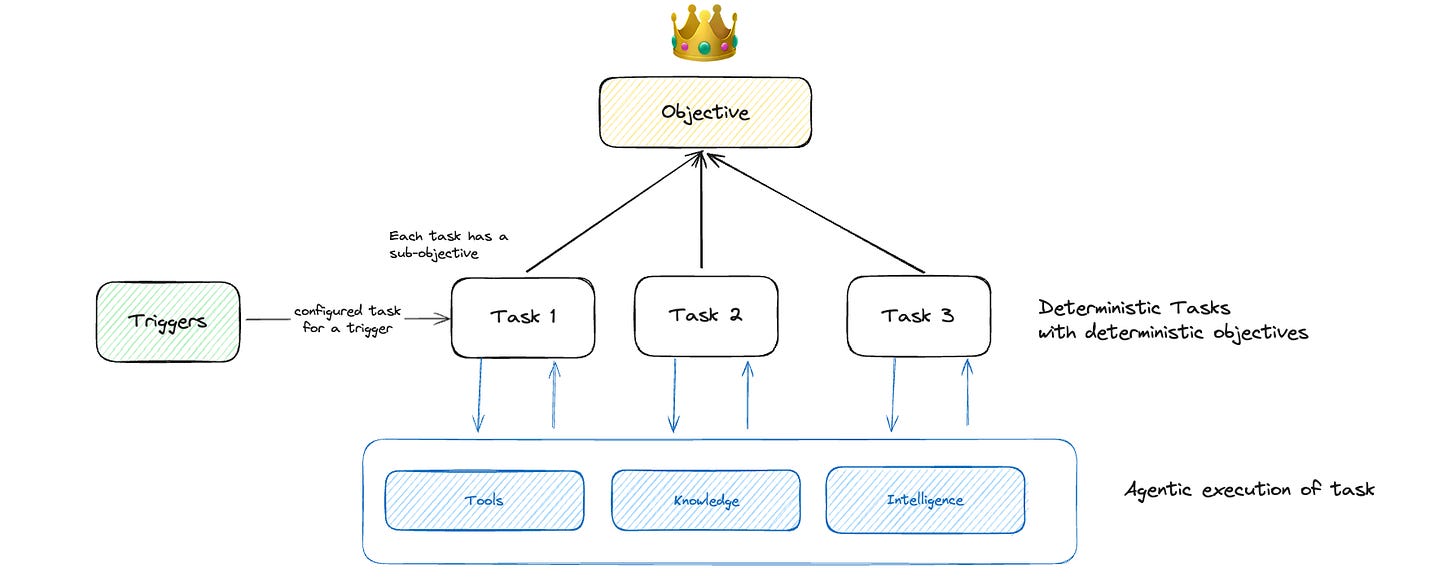Building Taskie, an AI-powered project manager
An essay on automating knowledge work by plugging intelligence in deterministic paths, and using AI-agents. Also, say hello to a Taskie.
I like Shreyas Doshi’s LNO framework. In essence, everything you do at work falls under one of three buckets: leverage, neutral, or overhead. Leverage tasks amplify your growth and impact. Neutral tasks, while necessary, don't move the needle much, but need to be done well. Overhead tasks are the drudgery – they consume time and energy but don't produce commensurate value, nor do they add to your growth.
As a product manager — most project management tasks fall into the overhead bucket. Scheduling meetings, updating task statuses, tracking progress – these tasks are essential, but they’re also a drain on time and focus. Time that could be better spent on strategy, innovation, or solving complex problems.
This got me thinking: what if we could automate these overhead tasks? Imagine an AI that handles all the mundane aspects of product management. It would free us up to focus on the high-leverage activities that truly matter.
In this post, I'll walk you through a framework to think about automating knowledge work. To keep things real, I’ll use an example of something I am working on along the way — creating an autonomous project manager called Taskie.
Taskie is a project manager that can be added to your workspace, and helps automate routine work. Taskie helps me today by requesting, and synthesizing project updates from teammates, and analyzing bug-reports to find systemic gaps. Taskie is still quite dumb, and doesn’t have much agency. It’ll improve soon!
The constructs of simple knowledge work
Project management, like most of knowledge work, has the following constructs:
Tasks: Action items or jobs that a project manager needs to perform. These are needed to move projects forward, from simple check-ins to complex processes.
Knowledge: Context about each task, including what needs to be done, why, and how it fits into the project.
Tools: Software like Linear and Slack used to manage tasks, communicate, and track progress.
Intelligence: The innate human intelligence of the project manager, and the intuitions they’ve built up through experience. This helps them take decisions, communicate, etc.
Triggers: Events or conditions that prompt the project manager to perform tasks. Such as deadlines, milestones, and notifications.
Approach: Overview

The approach, prompts, and the code for Taskie is public. You can read it here. If you want to dive into specifics, I suggest checking out the code directly. For a bird’s eye overview, continue reading.
The key to automating relatively simple tasks lies in integrating the constructs we talked about and outsourcing the intelligence to AI. We start with triggers – events like new Slack messages, weekly schedules, or bug reports that prompt action. These triggers set off tasks such as creating backlog tickets, analyzing bugs for improvements, drafting reports, and creating tasks to unblock engineers. What content to add, what communication to draft — these are simple decisions that get outsourced to an LLM.
Tools like Slack, Linear, and JIRA form the backbone of this system, enabling task management, communication, and progress tracking. These tools empower Taskie to act and communicate with the system, both to pull information and push output. Intelligence comes into play as Taskie makes decisions based on input, converting information into action or communication. Contextual knowledge about the product, codebase, and roadmap ensures that intelligence is applied within the context of the local work ecosystem — although, today Taskie has no additional knowledge.
Gaps: Deterministic paths vs Agents
If you read the code, you’d have noticed that Taskie isn’t agentic today. An agentic, or autonomous, system empowers AI to decide what tasks to perform for a trigger, and what tools to use for a task.
Today, Taskie’s paths are deterministic. Given a trigger, the tasks are coded in. For a task, the tools and when to use them, is coded in as well. Intelligence is used as another tool — to decide whether to proceed with an action or not, and to draft good comms. This makes Taskie reliable, but makes it dumb, and heavily constrained.
Humans have agency. In the context of the constructs we outlined, a human knowledge worker has three levels of agency:
Level 1: can decide what tools to use, how, and when, to perform a task
Level 2: can decide what tasks to perform in response to a trigger
Level 3: can create new workflows, i.e., configure new triggers, that lead to new tasks, and contribute to their overarching goal
Agentic systems have clearly articulated overarching goals that drive their decisions. E.g. a human project manager’s goal is to ensure that project’s at their organization are well managed, their systems and practices are constantly improving to meet the company’s goal of shipping reliably, and valuable improvements quickly.
More over an agentic system needs to be self-learning to be truly autonomous.
Next: making Taskie Agentic
Now that we’ve looked at a deterministic automation of some project management work in Taskie — it’s time to make Taskie agentic.
The plan is, by the next time I write, Taskie will have agentic execution of pre-defined tasks. It’ll make every task a mini-agent, that has a clear objective (completion of the task) and a set of tools at its disposal to achieve them. This will make Taskie a level 1 agentic autonomous system in the framework we defined earlier.
The next milestone in this project, will be to make Taskie even more agentic by giving it the autonomy to decide what tasks to perform, in response to a trigger, and craft new tasks, to achieve its objectives.
Do reach out if you agree/disagree with assumptions here, or are looking for help creating your own agentic systems. Fun times! Stay tuned.




